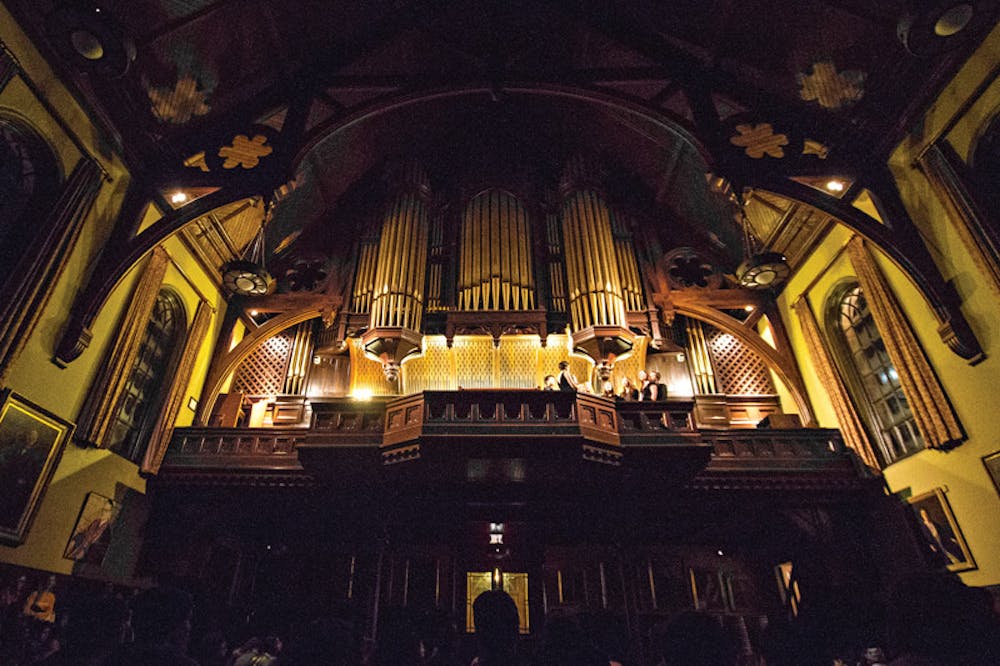As the clock struck midnight Monday morning, 500 undergraduates lay on the floor of Sayles Hall, anxiously awaiting the arrival of Mark Steinbach, University organist and lecturer in music. Pillows and blankets were strewn around the hall amidst makeshift forts and huddled bodies. Steinbach emerged onto the balcony, looking out to the crowd briefly before turning to face the instrument.
A seasoned organist and long-time Brown professor, Steinbach told The Herald he had no qualms going into the Midnight Organ Concert. “I need an audience to perform well,” he said.
The first notes from the organ were composed by French organist, Jehan Alain. The beautiful melody carried fluidly throughout the hall — as sounds drifted to the students’ ears, bodies moved naturally to the rhythm of the score.
Steinbach transitioned seamlessly between the works of Johann Sebastian Bach, Claude Debussy, Cesar Franck and Richard Strauss. By the end of the fifth piece, students sat up on their elbows in an attempt to glimpse Steinbach at the organ, stirred by his performance.
Steinbach was similarly impressed by his listeners. “I love looking down at the audience in the middle of the performance,” Steinbach said. “I can see all the faces, enthusiastically looking up at me, and I am always surprised by which pieces move people.”
At the end of his penultimate piece, Steinbach paused, anticipating the crowd’s reaction, before launching into his final piece. The crowd responded immediately, as students gasped, exchanged looks across the hall and shouted encouragement. The enthusiasm erupted in response to “Hedwig’s Theme” by John Williams, the most famous melody from the score of the “Harry Potter” films.
“It’s so fun to finish my recitals with the ‘Harry Potter’ piece,” Steinbach said.“The audience is taken by surprise and is excited to recognize a score.”
Steinbach takes great pride in his instrument. The organ looming in Sayles is a massive Hutchings-Votey, built in Boston in 1903. Upon first glance, viewers may believe the organ only comprises a keyboard and the large gold pipes mounted to the back of the hall. But two wooden doors across from the keyboard reveal numerous rows of pipes. Through the doors lie multiple access passageways used to repair the pipes and maintain their unique sound.
Ninety years after the organ was built, in 1993, Steinbach joined the University faculty in the music department. His arrival at the University revived the tradition of the Midnight Organ Concert. “The Sayles Hall organ was out of commission for a number of years,” Steinbach said. “It fell into a state of disrepair in the 1970s and then a hurricane hit and caused major water damage to the instrument. The University used insurance money to restore the organ.”
Over the past 22 years, Steinbach has worked tirelessly to perfect each of his performances. He has studied music his entire life and spends time each summer continuing his musical education. Steinbach spent this past summer taking an organ history tour in Germany, where he had the opportunity to play some of the oldest organs in the world — the oldest one dating back to 1588. Next summer, he will head to Paris, where he will play in the Notre Dame Cathedral.
“I’ve played all over the world,” Steinbach said, “but I’ve never played in Paris or in such a place as the Notre Dame Cathedral. I’m really excited.”
Steinbach is currently collaborating with two other composers at Brown on a pair of new pieces, slated to premiere on campus in fall 2016. “Knowing that people can be moved by this music inspires me to learn new pieces,” Steinbach said. “I want to bring music to life. Otherwise it would just be a score.”





